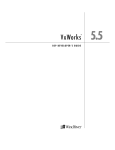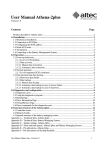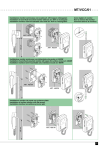Download VxWorks 5.1.1 - ELTEC Elektronik AG
Transcript
elektronik mainz
VxWorks 5.1.1
BSP Manual
for EUROCOM-17
Revision 1 A
eltec17(T)
Reference
eltec17(T)
NAME
Eltec EUROCOM-17
INTRODUCTION
This manual entry provides board-specific information necessary to run VxWorks. Before running VxWorks, verify that
the board runs in the factory configuration using vendorsupplied monitor program (RMon) and jumper settings, and
check operation through the RS-232 connection.
BOOT ROMS
The EUROCOM-17 uses a flash EPROM for the resident monitor
program (RMon) which is always resident on the EUROCOM-17.
The RMon performs various initialization functions on the
board and then optionally transfers to the program resident
within the user EPROM. The user EPROM, located at U1602, is
used to program VxWorks. This EPROM must be a 32 pin device
and can be from 128 Kbyte to 1 Mbyte (27C010 to 27C080).
The Rmon needs to be set up such that the RMon automatically
starts execution of the program resident in the user EPROM
memory. To set up the automatic start of the program in
user EPROM, set rotary switch number 2 to position 8 or
higher. When the switch is set in this manner, the RMon
will transfer control to the program located in the user
EPROM.
The EUROCOM-17 has non-volatile RAM; thus, boot parameters
are preserved whenever the system is powered off.
To load VxWorks, and for more information, follow the
instructions in the Getting Started chapter of the VxWorks
Programmer's Guide.
JUMPERS
The EUROCOM-17 factory configured for immediate operation
with VxWorks.
The table below lists the jumpers for the
EUROCOM-17.
Starred settings (*) indicate the factory
default and are appropriate for use with VxWorks.
Jumper
Description
____________________________________________________________
J1401
Watch dog period (closed * when 100 ms.)
(open when 1.6 seconds)
J1601
Flash programming voltage (open * when not present)
(closed when present)
J1605
Pin1 connection for EPROM (1-2 * when 5 volts)
(2-3 when A19)
Rev: 19 Oct 94
1
eltec17(T)
Reference
eltec17(T)
SWITCHES
The EUROCOM-17 has two rotary switches on the front panel of
the processor board. Switch number 1 is used to select the
VMEbus address (A32 and A16) for RMon.
The addressing is
as defined in the following table.
Position
A32 Space
A16 Space
_______________________________________________________
F
0xF0000000
0xF000
E
0xF0000000
0xF000
D
0xF0000000
0xF000
2
0x20000000
0x2000
1
0x10000000
0x1000
0
RMon defined
RMon defined
A24 addressing is always disbled by using the RMon defaults.
VxWorks can inherit the addressing asignments set up by
RMon,
if
desired.
When VxWorks is built with the
USE_RMON_CONFIG defined, then VxWorks will use the RMon
addressing.
When USE_RMON_CONFIG is not defined, the
addressing is set as per the LOCAL_MEM_BUS_ADRS definition
within config.h and the processor number.
Switch number 2 is used to select the start up mode that is
used by RMon.
For automatic transfer to the the VxWorks
programmed in the user EPROM, this swicth must be set to
positions 8 - F. All other positions will not perform an
automatic start of VxWorks.
Switch S3 on the front panel is used to select VME system
controller functions. When the EUROCOM-17 is placed in slot
1 of the VME chassis, the system controller option should be
selected.
When another processor is placed in slot 1, then
that processor will usually fulfill the system controller
function and th S3 should not select the system controller
function.
DEVICES
The cd2400Serial.c Cirrus Logic CD-2401 tty driver is provided for the four on-board serial ports; see the manual
entry for tyCoDrv.
The chip drivers included are:
nvRam.c - non-volatile RAM
z8536Timer.c - Zilog Counter/Timer Parallel
timer
vic064Vme.c - Cypress VIC-64 VME interface
Rev: 19 Oct 94
I/O
(CIO)
2
eltec17(T)
Reference
eltec17(T)
A network interface for the on-board ILACC chip allows
VxWorks to run without an additional network board. The
interface is called "il" and should be specified as the boot
device to the boot ROMs.
A device driver for the NCR 53C720 SCSI Input Output Processor (SIOP) is provided. The INCLUDE_SCSI directive must be
enabled in config.h.
SPECIAL CONSIDERATIONS
The ILACC chip needs to be informed of its Ethernet address
before it can attach to the LAN. The address is obtained
from the RMon EPROM which is unique for each board.
Console connection is through serial port number 1 which is
located on the the front connector. An adapter cable is
available for this interface. The adapter cable converts the
telephone jack connector to a D9 connection in the DCE configuration.
The NCR53C520 SCSI library supports SCSI wide and SCSI fast,
however, these features are currently not supported by the
SCSI library. Therefore, special functions are present to
place a compatible SCSI device in the fast and/or wide mode.
See the manual pages for sysScsiFast and sysScsiWide for
additional information.
The EUROCOM-17 has a watchdog fucntion that when enabled
must be triggerred at a minumum of the frequency selected by
the J1401 setting (100 ms.
or
1.6
seconds).
The
INCLUDE_WDOG
definition
within
config.h enables this
feature.
The VIC-64 VME interface driver provides an optional VME DMA
copy function which is enabled by the inclusion of the
INCLUDE_VIC_BLK_XFER definition within the config.h file.
See the manual entry for sysVicBlkCopy for additional information on block copies.
BOARD LAYOUT
The EUROCOM-17 does not have any jumpers that need be in set
positions
for
operation with VxWorks.
Refer to the
EUROCOM-17 technical manual for the locations of jumpers,
switches, and EPROMs.
SEE ALSO
Programmer's Guide: Getting Started, Configuration RMon Monitor Program - Programmers Reference Manual , RMon User
Manual - Software Manual , EUROCOM-17 Technical Manual
Rev: 19 Oct 94
3
sysLib(1)
VXWORKS REFERENCE MANUAL
sysLib(1)
NAME
sysLib - Eltec EUROCOM-17 system-dependent library
SYNOPSIS
sysNvRamGet() - get the contents of non-volatile RAM
sysNvRamSet() - write to non-volatile RAM
sysIntDisable() - disable a bus interrupt level
sysIntEnable() - enable a bus interrupt level
sysBusIntAck() - acknowledge a bus interrupt
sysBusIntGen() - generate a bus interrupt
sysMailboxConnect() - connect a routine to the mailbox
interrupt
sysMailboxEnable() - enable the mailbox interrupt
sysVicBlkEnable() - initialize the DMA copy operation for
the VIC-64.
sysVicBlkAdj() - adjust burst length and interleave period
for DMA transfers
sysVicBlkCopy() - copy blocks over the VMEbus using the
VIC's DMA feature
sysVicShow() - displays the contents of the VIC-64 registers
sysClkConnect() - connect a routine to the system clock
interrupt
sysClkInt() - handle a system clock interrupt
sysClkDisable() - turn off system clock interrupts
sysClkEnable() - turn on system clock interrupts
sysClkRateGet() - get the system clock rate
sysClkRateSet() - set the system clock rate
sysAuxClkConnect() - connect a routine to the auxiliary
clock interrupt
sysAuxClkDisable() - turn off auxiliary clock interrupts
sysAuxClkEnable() - turn on auxiliary clock interrupts
sysAuxClkRateGet() - get the auxiliary clock rate
sysAuxClkRateSet() - set the auxiliary clock rate
sysModel() - return the model name of the CPU board
sysBspRev() - return the bsp version with the revision eg
1.0/<x>
sysHwInit() - initialize the CPU board hardware
sysFrontPanelSwitch() - read the front panel switches
sysSetLed() - set value in LED
sysMemTop() - get the address of the top of memory
sysToMonitor() - transfer control to the ROM monitor
sysLocalToBusAdrs() - convert a local address to a bus
address
sysBusToLocalAdrs() - convert a bus address to a local
address
sysProcNumGet() - get the processor number
sysProcNumSet() - set the processor number
sysBusTas() - test and set a location across the bus
sysSysfailConnect() - connect a routine to the SYSFAIL
signal
sysAcfailConnect() - connect a routine to the ACFAIL signal
sysIlaccIntEnable() - enable the ILACC interrupt level
Rev: 19 Oct 94
4
sysLib(1)
VXWORKS REFERENCE MANUAL
sysLib(1)
STATUS sysNvRamGet
(char *string, int strLen, int offset)
STATUS sysNvRamSet
(char *string, int strLen, int offset)
STATUS sysIntDisable
(int intLevel)
STATUS sysIntEnable
(int intLevel)
int sysBusIntAck
(int intLevel)
STATUS sysBusIntGen
(int level, int vector)
STATUS sysMailboxConnect
(FUNCPTR routine, int arg)
STATUS sysMailboxEnable
(char *mailboxAdrs)
STATUS sysVicBlkEnable
(VOIDFUNCPTR * vector, int level, int burstLength,
int interleave)
STATUS sysVicBlkAdj
(int burstLength, int interleave)
STATUS sysVicBlkCopy
(char * localAddr, char * remoteAddr, int nbytes,
BOOL toVme)
intsysVicShow()
STATUS sysClkConnect
(FUNCPTR routine, int arg)
void sysClkInt
(void)
void sysClkDisable
(void)
void sysClkEnable
(void)
int sysClkRateGet
(void)
STATUS sysClkRateSet
(int ticksPerSecond)
STATUS sysAuxClkConnect
(FUNCPTR routine, int arg)
void sysAuxClkDisable
(void)
void sysAuxClkEnable
(void)
int sysAuxClkRateGet
(void)
STATUS sysAuxClkRateSet
(int ticksPerSecond)
char *sysModel
(void)
char * sysBspRev
(void)
void sysHwInit
Rev: 19 Oct 94
5
sysLib(1)
VXWORKS REFERENCE MANUAL
sysLib(1)
(void)
int sysFrontPanelSwitch
(int swNum)
int sysSetLed
(int hexVal)
char *sysMemTop
(void)
STATUS sysToMonitor
(int startType)
STATUS sysLocalToBusAdrs
(int adrsSpace, char *localAdrs, char **pBusAdrs)
STATUS sysBusToLocalAdrs
(int adrsSpace, char *busAdrs, char **pLocalAdrs)
int sysProcNumGet
(void)
void sysProcNumSet
(int procNum)
BOOL sysBusTas
(char *adrs)
STATUS sysSysfailConnect
(VOIDFUNCPTR routine, int arg)
STATUS sysAcfailConnect
(VOIDFUNCPTR routine, int arg)
int sysIlaccIntEnable
(int level)
DESCRIPTION
This library provides board-specific routines.
The chip
drivers included are:
nvRam.c
- non-volatile RAM library
cd2400Serial.c - Cirrus CD-2400 serial device module
library
z8536Timer.c
- Zilog 8536
Counter/Timer
device
library
vic064Vme.c
- Cypress VIC 068 VMEbus interface controller library
INCLUDE FILES
sysLib.h
SEE ALSO
Programmer's Guide: Configuration
Rev: 19 Oct 94
6
tyCoDrv(1)
VXWORKS REFERENCE MANUAL
tyCoDrv(1)
NAME
tyCoDrv - Eltec EUROCOM-17
driver
Cirrus
Logic
CD2400
MPCC
tty
SYNOPSIS
tyCoDrv() - tty driver initialization routine
tyCoDevCreate() - create a device for an on-board serial
port
STATUS tyCoDrv
(void)
STATUS tyCoDevCreate
(char * name, int channel, int rdBufSize,
int wrtBufSize)
DESCRIPTION
This is the driver for the Cirus Logic CD2400 MPCC.
the SCC's in asynchronous mode only.
It uses
USER-CALLABLE ROUTINES
Most of the routines in this driver are accessible only
through the I/O system.
Two routines, however, must be
called directly: tyCoDrv() to initialize the driver, and
tyCoDevCreate() to create devices.
Before the driver can be used, it must be initialized by
calling tyCoDrv().
This routine should be called exactly
once, before any reads, writes, or calls to tyCoDevCreate().
Normally, it is called from usrRoot() in usrConfig.c.
Before a terminal can be used, it must be created using
tyCoDevCreate().
Each port to be used should have exactly
one device associated with it by calling this routine.
IOCTL FUNCTIONS
This driver responds to the same ioctl() codes as a normal
tty driver; for more information, see the manual entry for
tyLib. The available baud rates are: 50, 110, 150, 300,
600, 1200, 2400, 3600, 4800, 7200, 9600, 19200, and 38400.
SEE ALSO
tyLib
Rev: 19 Oct 94
7
if_il(1)
VXWORKS REFERENCE MANUAL
if_il(1)
NAME
if_il - AMD 79900 ILACC Ethernet network interface driver
SYNOPSIS
ilattach() - publish the interface, and initialize the
driver and device
STATUS ilattach
(int unit, char *devAdrs, int ivec, int ilevel,
char *memAdrs, ULONG memSize, int memWidth, int spare,
int spare2)
DESCRIPTION
GENERAL INFORMATION
This module implements the AMD 79900 ILACC Ethernet
interface driver.
network
This driver is designed to achieve a moderate level of genericism, across the range of architectures and targets that
VxWorks 5.1 supports. This allows the driver to be run,
unmodified, on a variety of target hardware. To achieve
this goal, the driver must be given several target-specific
parameters, and some external support routines must be provided. These parameters, and the mechanisms used to communicate them to the driver, are detailed below. If any of the
assumptions mentioned below are not true for your particular
hardware, this driver will probably not function correctly.
This driver supports only one ILACC unit per CPU.
The
driver can be configured to support big-endian or littleendian architectures.
BOARD LAYOUT
This device is onboard.
No jumpering diagram required.
EXTERNAL INTERFACE
This driver provides the standard external interface with
the following exceptions. All initialization is performed
within the attach() routine and there is no separate init()
routine.
Therefore, in the global interface structure, the
function pointer to the init() routine is NULL.
There is one user-callable routine: ilattach().
manual entry for this routine for usage details.
See
the
TARGET SPECIFIC PARAMETERS
buss mode
- This parameter is globally accessed.
The ILACC control register #3 determines the buss mode
of the device. This allows the support of big-endian
and little-endian architectures.
This
parameter,
Rev: 19 Oct 94
8
if_il(1)
VXWORKS REFERENCE MANUAL
if_il(1)
defined as "u_short ilCSR_3B", is the value that will
be placed into ILACC control register #3. The default
value supports Motorola type busses. See the ILACC
manual to change this parameter.
base address of device registers
- This parameter is passed to the driver with
tach() routine.
the
ilat-
The ILACC presents two registers to the external interface, the RDP register, and the RAP register. This
driver assumes that these two registers occupy two
unique addresses in a memory space that is directly
accessable by the CPU executing this driver.
This
driver assumes that the RDP register is mapped at a
lower address than the RAP register, and is therefore
considered the "base address".
This parameter indicates to the driver
the RDP register.
where
interrupt vector
- This parameter is passed to the driver with
tach() routine.
to
the
find
ilat-
This driver configures the ILACC device to generate
hardware interrupts for various events within the device. Therefore, this driver contains an interrupt
handler routine.
This driver will call the VxWorks
system function intConnect() to connect its interrupt
handler to the interrupt vector generated as a result
of the ILACC interrupt.
interrupt level
- This parameter is passed to the driver with
tach() routine.
the
ilat-
Some target hardware use additional interrupt controller devices to help organize and service the various interrupt sources. This driver avoids all boardspecific knowledge of such devices. During the initialization of this driver, an external routine is
called
to
perform
any board-specific operations
required to allow the servicing of a ILACC interrupt.
This routine is described below. This parameter is
passed to the external routine.
shared memory address
Rev: 19 Oct 94
9
if_il(1)
VXWORKS REFERENCE MANUAL
- This parameter is passed to the driver with
tach() routine.
if_il(1)
the
ilat-
The ILACC device is a DMA type of device and typically
shares access to some region of memory with the CPU.
This driver is designed for systems that directly share
memory between the CPU and the ILACC. This driver
assumes that this shared memory is directly available
to this driver without any arbitration or timing concerns.
This parameter may be used to specify an explicit
memory region for use by the ILACC. This should be
used on hardware that restricts the ILACC to a particular memory region.
The constant NONE may be used to
indicate that there are no memory limitations. In this
case, the driver will attempt to allocate the shared
memory from the system space.
shared memory size
- This parameter is passed to the driver with
tach() routine.
the
ilat-
This parameter can be used to explicitly limit the
amount of shared memory (bytes) this driver will use.
The constant NONE may be used to indicate no specific
size limitation.
This parameter is only used if a
specific memory region is being provided to the driver.
shared memory width
- This parameter is passed to the driver with
tach() routine.
the
ilat-
Some target hardware that restricts the shared memory
region to a specific location, also restricts the
access width to this region by the CPU. On these targets, performing an access of an invalid width will
cause a buss error.
This parameter can be used to specify the number of
bytes of access width to be used by the driver during
access to the shared memory. The constant NONE may be
used to indicate no restrictions.
The current internal implementation of supporting this
mechanism is not robust, and may not work on all targets requiring these restrictions.
shared memory buffer size
Rev: 19 Oct 94
10
if_il(1)
VXWORKS REFERENCE MANUAL
if_il(1)
- This parameter is passed to the driver with
tach() routine.
the
ilat-
The driver and ILACC device exchange network data in
buffers.
This parameter allows you to limit the size
of these individual buffers. A value of zero indicates
that the default buffer size should be used. The
default buffer size is large enough to hold a maximum
size Ethernet packet.
Use of this parameter should be extremely rare.
Network performance will be affected, since the target
will no longer be able to receive all legal sizes of
packets.
Ethernet address
- This parameter is
memory location.
obtained
directly
from
a
global
During initialization, the driver needs to know the
Ethernet address for the ILACC device. The driver
assumes that this address is available in a global, 6
byte, character array, named ilEnetAddr[]. This array
is typically created and stuffed by the BSP code.
EXTERNAL SUPPORT REQUIREMENTS
This driver requires one external support routine to be provided.
void sysIlaccIntEnable (int level)
- This routine provides a target-specific
interrupt
for
the ILACC device.
involves interrupt controller hardware,
or external to the CPU. This routine
from the ilattach() routine.
enable of the
This typically
either internal
is called once,
SYSTEM RESOURCE USAGE
The driver requires the following system resources:
-
one mutual exclusion semaphore
one interrupt vector
5016 bytes in code section (text)
28 bytes in the initialized data section (data)
2244 bytes in the uninitialized data section (bss)
The sections are quoted for the MC68040
will vary for other architectures.
architecture
and
If the driver allocates the memory to share with the ILACC,
it does so by calling the cacheDmaMalloc() routine. The
Rev: 19 Oct 94
11
if_il(1)
VXWORKS REFERENCE MANUAL
if_il(1)
size requested is 80,542 bytes. If a memory region is provided to the driver, the size of this region is adjustable
to suit your needs.
The ILACC can only be operated if the shared memory region
is write-coherent with regards to the data cache. The
driver cannot maintain cache coherency for the device for
data that is written by the driver. This is because fields
within the shared structures are asynchronously modified by
both the driver, and the device, and these fields may share
the same cache line.
SEE ALSO
ifLib
Rev: 19 Oct 94
12
ncr720Lib(1)
VXWORKS REFERENCE MANUAL
ncr720Lib(1)
NAME
ncr720Lib - NCR 53C720 SCSI I/O Processor (SIOP) library
SYNOPSIS
ncr720CtrlCreate() - create a control structure for the SIOP
ncr720CtrlInit() - initialize a control structure for the
SIOP
ncr720SetHwRegister() - set Hardware dependant registers
ncr720Show() - Display values of all readable ncr720 (SIOP)
registers
NCR_720_SCSI_CTRL *ncr720CtrlCreate
(UINT8 *baseAdrs, UINT freqValue)
STATUS ncr720CtrlInit
(NCR_720_SCSI_CTRL *pSiop, int scsiCtrlBusId,
int scsiPriority)
STATUS ncr720SetHwRegister
(SIOP *pSiop, NCR720_HW_REGS *pHwRegs)
STATUS ncr720Show
(SCSI_CTRL *pScsiCtrl)
DESCRIPTION
This is the I/O driver for the NCR 53C720 SCSI I/O Processor
(SIOP).
It is designed to work in conjuction with scsiLib.
This driver runs in conjunction with a script program for
the NCR 53C720 chip.
The script uses the NCR 53C720 DMA
function for data transfers.
This driver supports cache
functions through cacheLib.
USER CALLABLE ROUTINES
Most of the routines in this driver are accessible only
through the I/O system. Three routines, however, must be
called directly: ncr720CtrlCreate() to create a controller
structure, and ncr720CtrlInit() to initialize it. The NCR
53C720 hardware registers need to be configured according to
the hardware implementation. If the default configuration
is not proper the routine ncr720SetHwRegister() should be
used to properly configure the registers.
INCLUDE FILES
ncr720.h, ncr720Script.h
SEE ALSO
scsiLib Programmer's Guide: I/O System
Rev: 19 Oct 94
13
ilattach(2)
VXWORKS REFERENCE MANUAL
ilattach(2)
NAME
ilattach() - publish
driver and device
SYNOPSIS
STATUS ilattach
(
int
unit,
char
*devAdrs,
int
ivec,
int
ilevel,
char
*memAdrs,
ULONG memSize,
int
memWidth,
int
spare,
int
spare2
)
the
/*
/*
/*
/*
/*
/*
/*
/*
/*
interface,
and
initialize
the
unit number
ILACC i/o address
interrupt vector
interrupt level
address of memory pool (-1 == malloc it)
only used if memory pool is NOT malloced
byte-width of data (-1 == any width)
not used
not used
DESCRIPTION
The routine publishes the "il" interface by filling in a
network interface record and adding this record to the system list. This routine also initializes the driver and the
device to the operational state.
The <memAdrs> parameter can be used to specify the location
of the memory that will be shared between the driver and the
device. The value NONE may be used to indicate that the
driver should obtain the memory.
The <memSize> parameter is only valid if the <memAdrs>
parameter is not set to NONE. In this case, this parameter
indicates the size of the provided memory region.
The <memWidth> parameter sets the memory pool's data port
width (in bytes); if NONE, any data width will be used.
RETURNS
OK or ERROR.
SEE ALSO
if_il
Rev: 19 Oct 94
14
*/
*/
*/
*/
*/
*/
*/
*/
*/
ncr720CtrlCreate(2) VXWORKS REFERENCE MANUAL
ncr720CtrlCreate(2)
NAME
ncr720CtrlCreate() - create a control structure for the SIOP
SYNOPSIS
NCR_720_SCSI_CTRL *ncr720CtrlCreate
(
UINT8 *baseAdrs, /* base address of the SIOP */
UINT
freqValue
/* clock controller
*/
)
DESCRIPTION
This routine creates an SIOP data structure and must be
called before using an SIOP chip. It should be called only
once for a given SIOP. Since it allocates memory for a
structure needed by all routines in ncr720Lib, it must be
called before any other routines in the library. After calling this routine, at least one call to ncr720CtrlInit()
should be perform before any SCSI transactions are initiated
using the SIOP.
A detailed description of the input parameters follows:
<baseAdrs>
- The address at which the CPU would
register of the SIOP.
access
the
lowest
<freqValue>
- The value at the SIOP SCSI CLK input. This is used to
determine the clock period for the scsi core of the
chip and the synchronous divider value for synchronous
transfer.
It is important to have the right timing on
the SCSI bus.
RETURNS
A pointer to NCR_720_SCSI_CTRL structure, or NULL if
is unavailable or there are bad parameters.
memory
SEE ALSO
ncr720Lib
Rev: 19 Oct 94
15
ncr720CtrlInit(2)
VXWORKS REFERENCE MANUAL
ncr720CtrlInit(2)
NAME
ncr720CtrlInit() - initialize a control
SIOP
SYNOPSIS
STATUS ncr720CtrlInit
(
NCR_720_SCSI_CTRL *pSiop,
struct
*/
int
scsiCtrlBusId,
SIOP
*/
int
scsiPriority
SCSI I/O */
)
structure
for
the
/* ptr to SIOP
/* SCSI bus ID of this
/* priority of a task when doing
DESCRIPTION
This routine initializes an SIOP structure, after the structure is created with ncr720CtrlCreate(). This structure
must be initialized before the SIOP can be used. It may be
called more than once if needed; however, it should only be
called while there is no activity on the SCSI interface.
Before using the SIOP, it must be initialized by calling
this routine.
Before returning, this routine pulses RST (reset)
SCSI bus, thus resetting all attached devices.
on
the
A detailed description of the input parameters follows:
<pSiop>
- a pointer to the NCR_720_SCSI_CTRL
with ncr720CtrlCreate().
structure
created
<scsiCtrlBusId>
- the SCSI bus ID of the SIOP.
Its value is somewhat
arbitrary:
seven (7), or highest priority, is conventional. The value must be in the range 0 - 7.
<scsiPriority>
- the priority to which a task is set when performing a
SCSI transaction.
Legal priorities are 0 to 255.
Alternately, a -1 indicates that the priority should
not be altered during SCSI transactions.
RETURNS
OK, or ERROR if parameters are out of range.
SEE ALSO
ncr720Lib
Rev: 19 Oct 94
16
ncr720SetHwRegister(2)VXWORKS REFERENCE MANUAnLcr720SetHwRegister(2)
NAME
ncr720SetHwRegister() - set Hardware dependant registers
SYNOPSIS
STATUS ncr720SetHwRegister
(
SIOP
*pSiop,
NCR720_HW_REGS *pHwRegs
)
/* Pointer to SIOP infos
*/
/* Pointer to a NCR720_HW_REGS info */
DESCRIPTION
This routine is used to set up the registers involved in the
hardware implementation of the chip. Typically, this routine is called by the sysScsiInit() routine from the bsp.
The
input
parameters
are
the
pointer returned by
ncr720CtrlCreate() and a pointer to a NCR720_HW_REGS structure that is filled with the logical values 0 or 1 for each
bit of each register describe bellow. This routine includes
only the bit registers that could modify the behavior of the
chip.
The
default
configuration
used
during
ncr720CtlrCreate(),
and
ncr720CrtlInit()
is
{0,0,0,0,1,0,0,0,0,0,0,0,0,1,0}
typedef struct
{
int ctest4Bit7;
int ctest0Bit7;
int ctest0Bit6;
int ctest0Bit5;
int ctest0Bit1;
int ctest2Bit5;
int ctest3Bit0;
int dmodeBit7;
int dmodeBit6;
int dmodeBit5;
int dmodeBit4;
int dmodeBit3;
int dmodeBit1;
int dcntlBit5;
int dcntlBit1;
} NCR720_HW_REGS;
/*
/*
/*
/*
/*
/*
/*
/*
/*
/*
/*
/*
/*
/*
/*
Host bus multiplex mode */
Disable/enable burst cache capability */
Snoop control bit1 */
Snoop control bit0 */
invert tt1 pin (sync bus host mode only) */
enable differential scsi bus capability*/
Set snoop pins mode */
Burst Lenght transfer bit 1 */
Burst Lenght transfer bit 0 */
Function code bit FC2 */
Function code bit FC1 */
Program data bit (FC0) */
user programmable transfer type */
Enable Ack pin */
Enable fast arbitration on host port */
To get a more detailled explanation regarding the description of each register involved see the User's Manual of the
NCR 53C720.
NOTE
Because this routine writes to the chip registers you
use it if there is any SCSI bus activity.
Rev: 19 Oct 94
can't
17
ncr720SetHwRegister(2)VXWORKS REFERENCE MANUAnLcr720SetHwRegister(2)
RETURNS
OK or ERROR if any input parameter is NULL
SEE ALSO
ncr720Lib, ncr720.h, ncr720CtlrCreate()
Rev: 19 Oct 94
18
ncr720Show(2)
VXWORKS REFERENCE MANUAL
ncr720Show(2)
NAME
ncr720Show() - Display values of all readable ncr720
registers
SYNOPSIS
STATUS ncr720Show
(
SCSI_CTRL *pScsiCtrl
)
(SIOP)
/* ptr to SCSI controller info */
DESCRIPTION
Displays the state of the SIOP registers in a user-friendly
way.
Primarily used during debugging. The input parameter
is the pointer to the SIOP info structure returned by the
ncr720CtrlCreate() call.
NOTE
The only readable register during a script execution is
Istat register. If you use this routine during the execution
of a SCSI comand the result will be unpredictable.
EXAMPLE
-> ncr720Show
NCR720 Registers
---------------0xfff47000: Scntl3 =
0xfff47004: Gpreg
=
0xfff47008: Sbcl
=
0xfff4700c: Sstat2 =
0xfff47010: Dsa
=
0xfff47014: Istat
=
0xfff47018: Ctest3 =
0xfff4701c: Temp
=
0xfff47020: Ctest6 =
0xfff47024: Dcmd/Ddc=
0xfff47028: Dnad
=
0xfff4702c: Dsp
=
0xfff47030: Dsps
=
0xfff47034: Scratch3=
0xfff47038: Dcntl
=
0xfff4703c: Adder
=
0xfff47040: Sist1
=
0xfff47046: Gpcntl =
0xfff4704a: RespID =
0xfff4704c: Stest3 =
0xfff47052: Sidl
=
0xfff47056: Sodl
=
0xfff4705a: Ssbdl
=
0xfff4705c: ScracthB=
value = 0 = 0x0
Rev: 19 Oct 94
0xa5 Scntl2 =
0x00 Sdid
=
0x00 Ssid
=
0x00 Sstat1 =
0x00000000
0x00
0x00 Ctest2 =
0x00000000
0x00 Ctest5 =
0x50000000
0x00066144
0x00066144
0x00066174
0x00 Scratch2=
0x21 Dwt
=
0x000cc2b8
0x00 Sist1
=
0x00 Macntl =
0x00 Stest2
0x0000
0x0000
0x0000
0x00000000
0x00
0x00
0x00
0x00
Scntl1
Sxfer
Socl
Sstat0
=
=
=
=
0x00
0x80
0x00
0x00
Scntl0
Scid
Sfbr
Dstat
=
=
=
=
0x04
0x80
0x00
0x80
0x21 Ctest1
= 0xf0 Ctest0
= 0x00
0x00 Ctest4
= 0x00 Dfifo
= 0x00
0x00 Scratch1= 0x00 Scratch0= 0x0a
0x00 Dien
= 0x37 Dmode
= 0x01
0x00 Sien1
0x00 Swide
Stime1
= 0x00 Stest1
=
=
=
=
0x00
0x00
0x00
0x00
Sien0
Slpar
Stime0
Stest0
19
=
=
=
=
0x00
0x00
0x00
0x00
ncr720Show(2)
VXWORKS REFERENCE MANUAL
ncr720Show(2)
SEE ALSO
ncr720Lib, ncr720CtrlCreate()
RETURNS
OK, or ERROR if
NULL.
Rev: 19 Oct 94
<pScsiCtrl>
and
<pSysScsiCtrl>
are
both
20
sysAcfailConnect(2) VXWORKS REFERENCE MANUAL
sysAcfailConnect(2)
NAME
sysAcfailConnect() - connect a routine to the ACFAIL signal
SYNOPSIS
STATUS sysAcfailConnect
(
VOIDFUNCPTR routine,
int
arg
)
/* routine to be connected to ACFAIL signal */
/* argument with which to call routine
*/
DESCRIPTION
This routine connects a specified
ACFAIL signal.
RETURNS
OK, or ERROR if the
interrupt.
routine
routine
cannot
be
to
the
connected
board's
to
the
SEE ALSO
sysLib, intConnect()
Rev: 19 Oct 94
21
sysAuxClkConnect(2) VXWORKS REFERENCE MANUAL
sysAuxClkConnect(2)
NAME
sysAuxClkConnect() - connect
clock interrupt
a
routine
to
the
auxiliary
SYNOPSIS
STATUS sysAuxClkConnect
(
FUNCPTR routine, /* routine called at each aux clock interrupt */
int
arg
/* argument with which to call routine
*/
)
DESCRIPTION
This routine specifies the interrupt service routine to be
called at each auxiliary clock interrupt. It also connects
the clock error interrupt service routine.
RETURNS
OK, or ERROR if the
interrupt.
routine
cannot
be
connected
to
the
SEE ALSO
sysLib, intConnect(), sysAuxClkEnable()
Rev: 19 Oct 94
22
sysAuxClkDisable(2) VXWORKS REFERENCE MANUAL
sysAuxClkDisable(2)
NAME
sysAuxClkDisable() - turn off auxiliary clock interrupts
SYNOPSIS
void sysAuxClkDisable (void)
DESCRIPTION
This routine disables auxiliary clock interrupts.
RETURNS
N/A
SEE ALSO
sysLib, sysAuxClkEnable()
Rev: 19 Oct 94
23
sysAuxClkEnable(2)
VXWORKS REFERENCE MANUAL
sysAuxClkEnable(2)
NAME
sysAuxClkEnable() - turn on auxiliary clock interrupts
SYNOPSIS
void sysAuxClkEnable (void)
DESCRIPTION
This routine enables auxiliary clock interrupts.
RETURNS
N/A
SEE ALSO
sysLib, sysAuxClkDisable()
Rev: 19 Oct 94
24
sysAuxClkRateGet(2) VXWORKS REFERENCE MANUAL
sysAuxClkRateGet(2)
NAME
sysAuxClkRateGet() - get the auxiliary clock rate
SYNOPSIS
int sysAuxClkRateGet (void)
DESCRIPTION
This routine returns the interrupt
clock.
rate
of
the
auxiliary
RETURNS
The number of ticks per second of the auxiliary clock.
SEE ALSO
sysLib, sysAuxClkEnable(), sysAuxClkRateSet()
Rev: 19 Oct 94
25
sysAuxClkRateSet(2) VXWORKS REFERENCE MANUAL
sysAuxClkRateSet(2)
NAME
sysAuxClkRateSet() - set the auxiliary clock rate
SYNOPSIS
STATUS sysAuxClkRateSet
(
int ticksPerSecond
)
/* number of clock interrupts per second */
DESCRIPTION
This routine sets the interrupt rate of the auxiliary clock.
If the auxiliary clock is currently enabled, the clock is
disabled and then re-enabled with the new rate.
RETURNS
OK or ERROR.
SEE ALSO
sysLib, sysAuxClkEnable(), sysAuxClkRateGet()
Rev: 19 Oct 94
26
sysBspRev(2)
VXWORKS REFERENCE MANUAL
sysBspRev(2)
NAME
sysBspRev() - return the bsp version with
1.0/<x>
the
revision
eg
SYNOPSIS
char * sysBspRev (void)
DESCRIPTION
This function returns a pointer to a bsp version with the
revision.
for eg. 1.0/<x>. BSP_REV defined in config.h is
concatanated to BSP_VERSION defined in bspVersion.h and
returned.
RETURNS
A pointer to the BSP version/revision string.
SEE ALSO
sysLib
Rev: 19 Oct 94
27
sysBusIntAck(2)
VXWORKS REFERENCE MANUAL
sysBusIntAck(2)
NAME
sysBusIntAck() - acknowledge a bus interrupt
SYNOPSIS
int sysBusIntAck
(
int intLevel
)
/* interrupt level to acknowledge */
DESCRIPTION
This routine acknowledges a specified VMEbus interrupt
level. The VIC-64 performs this function automatically.
RETURNS
NULL. Performed by hadrware
SEE ALSO
sysLib, sysBusIntGen()
Rev: 19 Oct 94
28
sysBusIntGen(2)
VXWORKS REFERENCE MANUAL
sysBusIntGen(2)
NAME
sysBusIntGen() - generate a bus interrupt
SYNOPSIS
STATUS sysBusIntGen
(
int level, /* VMEbus interrupt level to generate (1-7) */
int vector /* interrupt vector to generate (0-255)
*/
)
DESCRIPTION
This routine generates a bus interrupt for a specified level
with a specified vector.
RETURNS
OK, ERROR if interrupt level out of range (1 - 7) or vector
is out of range (0 - 255) or a previous unacknowledged
interrupt is pending.
SEE ALSO
sysLib, sysBusIntAck()
Rev: 19 Oct 94
29
sysBusTas(2)
VXWORKS REFERENCE MANUAL
sysBusTas(2)
NAME
sysBusTas() - test and set a location across the bus
SYNOPSIS
BOOL sysBusTas
(
char *adrs
)
/* address to be tested and set */
DESCRIPTION
This routine performs
across the backplane.
a
680x0
test-and-set
instruction
RETURNS
TRUE (successful set), or FALSE (failure).
SEE ALSO
sysLib, vxTas()
Rev: 19 Oct 94
30
sysBusToLocalAdrs(2)VXWORKS REFERENCE MANUAL sysBusToLocalAdrs(2)
NAME
sysBusToLocalAdrs() - convert
address
a
bus
address
to
a
local
SYNOPSIS
STATUS sysBusToLocalAdrs
(
int
adrsSpace,
/* bus address space in which busAdrs resides */
char *busAdrs,
/* bus address to convert
*/
char **pLocalAdrs /* where to return local address
*/
)
DESCRIPTION
This routine gets the local address that accesses
fied VMEbus address.
RETURNS
OK, or ERROR if the address space is unknown or the
is not possible.
a
speci-
mapping
SEE ALSO
sysLib, sysLocalToBusAdrs()
Rev: 19 Oct 94
31
sysClkConnect(2)
VXWORKS REFERENCE MANUAL
sysClkConnect(2)
NAME
sysClkConnect() - connect a
interrupt
SYNOPSIS
STATUS sysClkConnect
(
FUNCPTR routine,
int
arg
)
routine
to
the
system
clock
/* routine called at each system clock interrupt */
/* argument with which to call routine
*/
DESCRIPTION
This routine specifies the interrupt service routine to be
called at each clock interrupt. It is called from usrRoot()
in usrConfig.c to connect usrClock() to the system clock
interrupt.
It also connects the clock error interrupt service routine.
RETURNS
OK, or ERROR if the
interrupt.
routine
cannot
be
connected
to
the
SEE ALSO
sysLib, intConnect(), usrClock(), sysClkEnable()
Rev: 19 Oct 94
32
sysClkDisable(2)
VXWORKS REFERENCE MANUAL
sysClkDisable(2)
NAME
sysClkDisable() - turn off system clock interrupts
SYNOPSIS
void sysClkDisable (void)
DESCRIPTION
This routine disables system clock interrupts.
RETURNS
N/A
SEE ALSO
sysLib, sysClkEnable()
Rev: 19 Oct 94
33
sysClkEnable(2)
VXWORKS REFERENCE MANUAL
sysClkEnable(2)
NAME
sysClkEnable() - turn on system clock interrupts
SYNOPSIS
void sysClkEnable (void)
DESCRIPTION
This routine enables system clock interrupts.
RETURNS
N/A
SEE ALSO
sysLib, sysClkConnect(), sysClkDisable(), sysClkRateSet()
Rev: 19 Oct 94
34
sysClkInt(2)
VXWORKS REFERENCE MANUAL
sysClkInt(2)
NAME
sysClkInt() - handle a system clock interrupt
SYNOPSIS
void sysClkInt (void)
DESCRIPTION
This routine handles a system clock interrupt.
It acknowledges the interrupt and calls the routine installed by
sysClkConnect().
SEE ALSO
sysLib
Rev: 19 Oct 94
35
sysClkRateGet(2)
VXWORKS REFERENCE MANUAL
sysClkRateGet(2)
NAME
sysClkRateGet() - get the system clock rate
SYNOPSIS
int sysClkRateGet (void)
DESCRIPTION
This routine returns the interrupt rate of the system clock.
RETURNS
The number of ticks per second of the system clock.
SEE ALSO
sysLib, sysClkEnable(), sysClkRateSet()
Rev: 19 Oct 94
36
sysClkRateSet(2)
VXWORKS REFERENCE MANUAL
sysClkRateSet(2)
NAME
sysClkRateSet() - set the system clock rate
SYNOPSIS
STATUS sysClkRateSet
(
int ticksPerSecond
)
/* number of clock interrupts per second */
DESCRIPTION
This routine sets the interrupt rate of the system clock.
The new interrupt rate is saved. If the system clock is
currently enabled, the clock is disabled and then re-enabled
with the new rate. This routine is called by usrRoot() in
usrConfig.c.
NOTE
The valid range for the system clock is 40 to 5000 ticks per
second.
RETURNS
OK, or ERROR if the tick rate is invalid or the timer cannot
be set.
SEE ALSO
sysLib, sysClkEnable(), sysClkRateGet()
Rev: 19 Oct 94
37
sysHwInit(2)
VXWORKS REFERENCE MANUAL
sysHwInit(2)
NAME
sysHwInit() - initialize the CPU board hardware
SYNOPSIS
void sysHwInit (void)
DESCRIPTION
This routine initializes various features of the CPU board
hardware. It is called from usrInit() in usrConfig.c.
NOTE
This routine should not be called by the user.
RETURNS
N/A
SEE ALSO
sysLib
Rev: 19 Oct 94
38
sysIlaccIntEnable(2)VXWORKS REFERENCE MANUAL sysIlaccIntEnable(2)
NAME
sysIlaccIntEnable() - enable the ILACC interrupt level
SYNOPSIS
int sysIlaccIntEnable
(
int level /* interrupt level, not used */
)
DESCRIPTION
This routine enables interrupts for the on-board ILACC chip
at a specified level. ILACC interrupts are controlled by
the VIC chip. The VIC chip also provides the interrupt vector.
RETURNS
OK
SEE ALSO
sysLib
Rev: 19 Oct 94
39
sysIntDisable(2)
VXWORKS REFERENCE MANUAL
sysIntDisable(2)
NAME
sysIntDisable() - disable a bus interrupt level
SYNOPSIS
STATUS sysIntDisable
(
int intLevel /* interrupt level to disable (1-7) */
)
DESCRIPTION
This routine disables a specified VMEbus interrupt level.
RETURNS
OK, or ERROR if <intLevel> is not in the range 1 - 7.
SEE ALSO
sysLib, sysIntEnable()
Rev: 19 Oct 94
40
sysIntEnable(2)
VXWORKS REFERENCE MANUAL
sysIntEnable(2)
NAME
sysIntEnable() - enable a bus interrupt level
SYNOPSIS
STATUS sysIntEnable
(
int intLevel /* interrupt level to enable (1-7) */
)
DESCRIPTION
This routine enables a specified VMEbus interrupt level.
RETURNS
OK, or ERROR if <intLevel> is not in the range 1 - 7.
SEE ALSO
sysLib, sysIntDisable()
Rev: 19 Oct 94
41
sysLocalToBusAdrs(2)VXWORKS REFERENCE MANUAL sysLocalToBusAdrs(2)
NAME
sysLocalToBusAdrs() - convert
address
a
local
address
to
a
bus
SYNOPSIS
STATUS sysLocalToBusAdrs
(
int
adrsSpace,
/* bus address space in which busAdrs resides */
char *localAdrs, /* local address to convert
*/
char **pBusAdrs
/* where to return bus address
*/
)
DESCRIPTION
This routine gets the VMEbus address that accesses a
fied local memory address.
speci-
RETURNS
OK, or ERROR if the mapping is not possible.
SEE ALSO
sysLib, sysBusToLocalAdrs()
Rev: 19 Oct 94
42
sysMailboxConnect(2)VXWORKS REFERENCE MANUAL sysMailboxConnect(2)
NAME
sysMailboxConnect() interrupt
connect
a
routine
to
the
mailbox
SYNOPSIS
STATUS sysMailboxConnect
(
FUNCPTR routine, /* routine called at each mailbox interrupt */
int
arg
/* argument with which to call routine
*/
)
DESCRIPTION
This routine specifies the interrupt service routine
called at each mailbox interrupt.
to
be
RETURNS
OK, always
SEE ALSO
sysLib, intConnect(), sysMailboxEnable()
Rev: 19 Oct 94
43
sysMailboxEnable(2) VXWORKS REFERENCE MANUAL
sysMailboxEnable(2)
NAME
sysMailboxEnable() - enable the mailbox interrupt
SYNOPSIS
STATUS sysMailboxEnable
(
char *mailboxAdrs /* address of mailbox (ignored) */
)
DESCRIPTION
This routine enables the ICMS-0 mailbox on the VIC064.
RETURNS
OK, always.
SEE ALSO
sysLib, sysMailboxConnect()
Rev: 19 Oct 94
44
sysMemTop(2)
VXWORKS REFERENCE MANUAL
sysMemTop(2)
NAME
sysMemTop() - get the address of the top of memory
SYNOPSIS
char *sysMemTop (void)
DESCRIPTION
This routine finds the size of memory.
RETURNS
The address of the top of memory.
SEE ALSO
sysLib
Rev: 19 Oct 94
45
sysModel(2)
VXWORKS REFERENCE MANUAL
sysModel(2)
NAME
sysModel() - return the model name of the CPU board
SYNOPSIS
char *sysModel (void)
DESCRIPTION
This routine returns the model name of the CPU board.
RETURNS
A pointer to the string "Eltec EUROCOM-17".
SEE ALSO
sysLib
Rev: 19 Oct 94
46
sysNvRamGet(2)
VXWORKS REFERENCE MANUAL
sysNvRamGet(2)
NAME
sysNvRamGet() - get the contents of non-volatile RAM
SYNOPSIS
STATUS sysNvRamGet
(
char *string,
int
strLen,
int
offset
)
/* where to copy non-volatile RAM
*/
/* maximum number of bytes to copy
*/
/* byte offset into non-volatile RAM */
DESCRIPTION
This routine copies the contents of non-volatile memory into
a specified string. The string will be terminated with an
EOS.
RETURNS
OK, or ERROR if
range.
access
is
outside
the
non-volatile
RAM
SEE ALSO
sysLib, sysNvRamSet()
Rev: 19 Oct 94
47
sysNvRamSet(2)
VXWORKS REFERENCE MANUAL
sysNvRamSet(2)
NAME
sysNvRamSet() - write to non-volatile RAM
SYNOPSIS
STATUS sysNvRamSet
(
char *string,
int
strLen,
int
offset
)
/* string to be copied into non-volatile RAM */
/* maximum number of bytes to copy
*/
/* byte offset into non-volatile RAM
*/
DESCRIPTION
This routine copies a
RAM.
RETURNS
OK, or ERROR if
range.
access
specified
is
string
outside
the
into
non-volatile
non-volatile
RAM
SEE ALSO
sysLib, sysNvRamGet()
Rev: 19 Oct 94
48
sysProcNumGet(2)
VXWORKS REFERENCE MANUAL
sysProcNumGet(2)
NAME
sysProcNumGet() - get the processor number
SYNOPSIS
int sysProcNumGet (void)
DESCRIPTION
This routine returns the processor number for the CPU board,
which is set with sysProcNumSet().
RETURNS
The processor number for the CPU board.
SEE ALSO
sysLib, sysProcNumSet()
Rev: 19 Oct 94
49
sysProcNumSet(2)
VXWORKS REFERENCE MANUAL
sysProcNumSet(2)
NAME
sysProcNumSet() - set the processor number
SYNOPSIS
void sysProcNumSet
(
int procNum
)
DESCRIPTION
This routine sets the processor number for the CPU board.
Processor numbers should be unique on a single backplane.
RETURNS
N/A
SEE ALSO
sysLib, sysProcNumGet()
Rev: 19 Oct 94
50
sysSetLed(2)
VXWORKS REFERENCE MANUAL
sysSetLed(2)
NAME
sysSetLed() - set value in LED
SYNOPSIS
int sysSetLed
(
int hexVal
)
/* value to display in LED display */
DESCRIPTION
This routine sets a value into the hex display.
When the
value to display is negative, then the display will be
blanked.
RETURNS
OK
SEE ALSO
sysLib
Rev: 19 Oct 94
51
sysSysfailConnect(2)VXWORKS REFERENCE MANUAL sysSysfailConnect(2)
NAME
sysSysfailConnect() - connect a routine to the SYSFAIL
nal
SYNOPSIS
STATUS sysSysfailConnect
(
VOIDFUNCPTR routine,
int
arg
)
/* routine to be connected to SYSFAIL signal */
/* argument with which to call routine
*/
DESCRIPTION
This routine connects a specified
SYSFAIL signal.
RETURNS
OK, or ERROR if the
interrupt.
sig-
routine
routine
cannot
be
to
the
connected
board's
to
the
SEE ALSO
sysLib, intConnect()
Rev: 19 Oct 94
52
sysToMonitor(2)
VXWORKS REFERENCE MANUAL
sysToMonitor(2)
NAME
sysToMonitor() - transfer control to the ROM monitor
SYNOPSIS
STATUS sysToMonitor
(
int startType /* parameter passed to ROM to tell it how to boot */
)
DESCRIPTION
This routine transfers control to the ROM monitor.
Normally, it is called only by reboot()--which services ^X--and
bus errors at interrupt level.
However, in some circumstances, the user may wish to introduce a <startType> to
enable special boot ROM facilities.
RETURNS
Does not return.
SEE ALSO
sysLib
Rev: 19 Oct 94
53
sysVicBlkAdj(2)
VXWORKS REFERENCE MANUAL
sysVicBlkAdj(2)
NAME
sysVicBlkAdj() - adjust burst length and
for DMA transfers
SYNOPSIS
STATUS sysVicBlkAdj
(
int burstLength,
int interleave
)
interleave
period
/* burst length of DMA block transfer (1-64) */
/* interleave period between bursts (1-15)
*/
DESCRIPTION
This routine changes the burst length and interleave period
that are to be used for VME DMA transfers. <burstLength> is
the number of VMEbus cycles per burst, <interleave> is the
local cycle interleave period between block transfers. The
interleave time is equal to 250ns times <interleave>.
RETURNS
OK, or ERROR if parameters are out of range.
SEE ALSO
sysLib, sysVicBlkEnable(), sysVicBlkCopy()
Rev: 19 Oct 94
54
sysVicBlkCopy(2)
VXWORKS REFERENCE MANUAL
sysVicBlkCopy(2)
NAME
sysVicBlkCopy() - copy blocks
VIC's DMA feature
SYNOPSIS
STATUS sysVicBlkCopy
(
char * localAddr,
char * remoteAddr,
int
nbytes,
BOOL
toVme
)
/*
/*
/*
/*
over
the
VMEbus
using
the
local address
vme address
transfer length in bytes
copy local memory to vme (or vise-versa)
DESCRIPTION
This routine uses the DMA feature of the VIC to do blockmode copies to/from the VMEbus. This routine takes a local
address <localAddr> and remote address <remoteAddr> and
tranfers <nbytes> bytes in the direction specified by
<toVme>.
RETURNS
OK, or ERROR if transfer was unsuccessful.
Unsuccessful
transfers result from bus errors or bad alignments.
SEE ALSO
sysLib, sysVicBlkEnable(), sysVicBlkAdj()
Rev: 19 Oct 94
55
*/
*/
*/
*/
sysVicBlkEnable(2)
VXWORKS REFERENCE MANUAL
sysVicBlkEnable(2)
NAME
sysVicBlkEnable() - initialize the DMA
the VIC-64.
copy
operation
for
SYNOPSIS
STATUS sysVicBlkEnable
(
VOIDFUNCPTR * vector,
/* interrupt vector for DMA done interrupt
*/
int
level,
/* interrupt level for DMA done interrupt
*/
int
burstLength, /* burst length of DMA block transfer (164) */
int
interleave
/* interleave period between bursts (115)
*/
)
DESCRIPTION
This routine initializes operations for DMA transfers using
the VIC-64. The DAM done interrupt is attached using the
<vector> as the interrupt vector and <level> as the interrupt level.
<burstLength> is the number of VMEbus cycles
per burst, <interleave> is the local cycle interleave period
between block transfers.
The interleave time is equal to
250ns times <interleave>.
This routine is typically called by sysHwInit2().
RETURNS
OK or ERROR, if the DMA paramters are not valid.
SEE ALSO
sysLib, sysVicBlkAdj(), sysVicBlkCopy()
Rev: 19 Oct 94
56
sysVicShow(2)
VXWORKS REFERENCE MANUAL
sysVicShow(2)
NAME
sysVicShow() - displays the contents of the VIC-64 registers
SYNOPSIS
int sysVicShow()
DESCRIPTION
This routine displays the contents of the VIC-64 registers.
RETURNS
OK, always.
SEE ALSO
sysLib,
Rev: 19 Oct 94
57
tyCoDevCreate(2)
VXWORKS REFERENCE MANUAL
tyCoDevCreate(2)
NAME
tyCoDevCreate() - create a device
port
SYNOPSIS
STATUS tyCoDevCreate
(
char * name,
int
channel,
int
rdBufSize,
int
wrtBufSize
)
/*
/*
/*
/*
for
an
on-board
serial
name to use for this device
physical channel for this device
read buffer size, in bytes
write buffer size, in bytes
DESCRIPTION
This routine creates a device on a specified serial port.
Each port to be used should have exactly one device associated with it by calling this routine.
For instance, to create the device "/tyCo/0",
sizes of 512 bytes, the proper call would be:
with
buffer
tyCoDevCreate ("/tyCo/0", 0, 512, 512);
RETURNS
OK, or ERROR if the driver is not installed or
is invalid.
the
channel
SEE ALSO
tyCoDrv
Rev: 19 Oct 94
58
*/
*/
*/
*/





































































